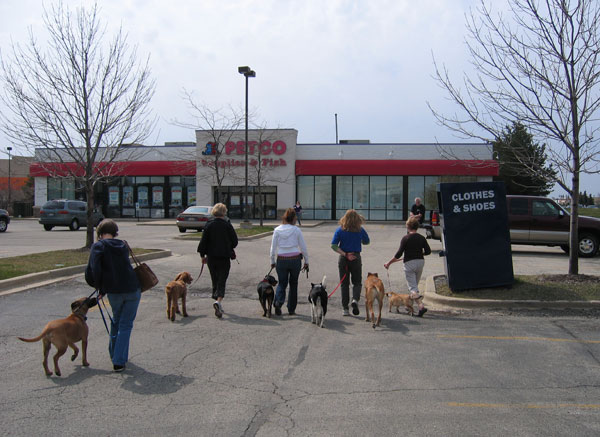10 Tips For Your New Puppy
Willow‘s puppies all went home today with their new forever families. Here are tips for all families that bring home a new puppy:
 Limit the number of rooms the puppy/dog has access to for the first week or so.
Limit the number of rooms the puppy/dog has access to for the first week or so.- Limit the amount of “attention” you give the new member of your family for the first few days…let them get acclimated a bit.
- Place the crate in a bedroom for the first few nights or sleep next to the crate. Remember, all the puppies slept lumped together, spending the night alone will really be scary and having you nearby will greatly help.
- Unless you want a dog that whines in her crate, do not let her out when she is crying/whining/pawing or barking. Wait until she quiets and then let her out. To avoid this, set an alarm for every 3 or 4 hours that first night and wake her up to take her potty. Soon you will be able to cut out those middle of the night potty breaks but if you do this for that first few nights (first week?) it will really pay off. The alternative, letting the dog wake you up can lead to reinforcing whining and barking in the crate. We don’t want that!
 Take your new family member to the same spot in the yard every time he transitions to a new activity (or every hour or two) and tell him “go potty” or some such command. If nothing happens in a few minutes, come back inside.
Take your new family member to the same spot in the yard every time he transitions to a new activity (or every hour or two) and tell him “go potty” or some such command. If nothing happens in a few minutes, come back inside.- Watch for nervous behavior, circling and sniffing the ground, whining – these are cues that your puppy needs to poop.
- You have 3 seconds to reward or correct a behavior! That’s it! So, unless you catch the puppy in the act of peeing, scolding him will only make him afraid of you. If you miss it, let it go and commit to being more attentive in the future.
- Your puppy won’t need a real walk until they are about 4 months of age but do get them used to their leash and collar by putting them on and walking around the yard and house.
- Remember: these guys (Willow included) are like blank slates…they will learn what you teach them or let them do regularly. Be mindful not to condition them to expect behavior that you won’t want a full grown dog to do. A good example, letting them pull you to the door. As anxious as you are to get the out to potty, try to keep good leash manners in front of your mind. Walk to the door with the dog/pup at you side or behind you. Go out the door first, then the pup/dog. Once outside, give a command word as you walk to your potty spot and then let them have full reign of the leash. Otherwise, you are teaching a dog to pull on leash while you are house training it!
 Remember to love them up good but don’t “cut them slack” – keep in mind the behavior you want and reinforce it (with cuddles, praise and treats) and ignore or correct (NOT PUNISH – just make a disapproving sound – I like AH!) behavior you don’t want. They will appreciate the clarity.
Remember to love them up good but don’t “cut them slack” – keep in mind the behavior you want and reinforce it (with cuddles, praise and treats) and ignore or correct (NOT PUNISH – just make a disapproving sound – I like AH!) behavior you don’t want. They will appreciate the clarity.
Cherish your new family member!
Creating a good dog walking experience
Ahh, nothing better than walking a dog on a lovely spring day. How about we all go together? What? Can’t? The dog “doesn’t like other dogs? People either? The dog’s leashes will get all tangled up and cause a minor disaster? eh, too much work, you’re right, let’s just skip it and let them out back.
So SAD! There is a sense of peacefulness that comes from walking with a group of dogs that can’t be matched. Dogs are pack animals, meaning they like to be with other dogs. Some of them just don’t know that or have forgotten. We are sort of pack animals too, we like to be together. So getting your dog to have nice leash manners is a skill that helps you both fulfill this urge to be together with your own kind in a productive, peaceful way.
Ok, so what are “nice” leash manners? Nice means: no pulling, no tripping me up, no tripping anyone else up, no growling or snapping at other beings, no incessant stopping to sniff every little thing, no lunging after the neighbor’s cat or the neighborhood rabbit or squirrel or deer or elephant (I don’t know where you live), no barking at anything, and generally enjoying being together.
Placement has a lot to do with fostering “nice” manners. A dog in front is a dog in charge and if that dog has anything other than a laid back, pacifist sort of personality they shouldn’t be in charge. Most dogs, nearly every single dog I’ve ever seen are much happier with you in charge of the walk. Really, much HAPPIER. Don’t confuse excitement – that frantic panting jumping barking energy for happiness. A happy dog is a calm dog that looks content. A hyper dog isn’t happy, he’s crazy. We don’t want crazy people leading us nor do we want crazy dogs leading us.
So, keep your dog at your side. Draw an invisible line from your knees out to either side of you and that is the line the dog should stay behind at all times. Walking like this gives a dog a job, a sense of purpose. Try it yourself…when you’re out walking with a friend try to keep yourself behind their invisible line. It takes mindfulness of what you are doing and that is what we are after with out dogs. It is a mental. challenge.
Now, doing this can be difficult. A dog who is used to leading isn’t going to give up that position instantly. Mostly because they have been conditioned to walk there – it is what they know. You have to show them a new way. If you’re consistent, soon that will be what they know. To keep them at your side you have to shorten the length of leash between you and your dog. For that reason, I always suggest using a simple nylon, one ply, 1/2 inch leash no longer than 4 feet. And I suggest tying a knot in the leash where your hand should fall. That way you always know if you’re holding the leash in the right spot. People who train with me always get their leashes tied. It’s just my thing.





